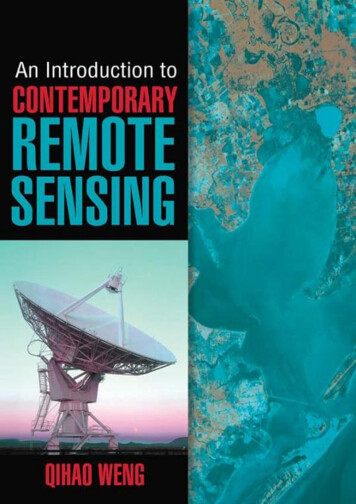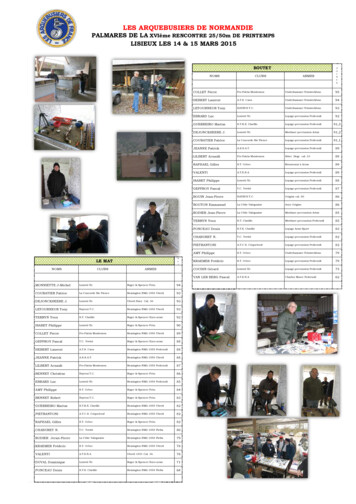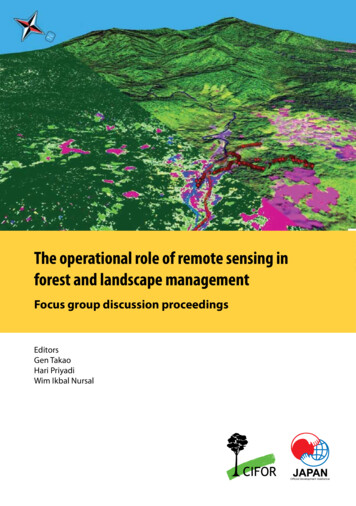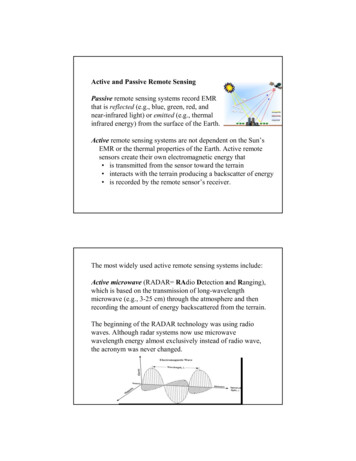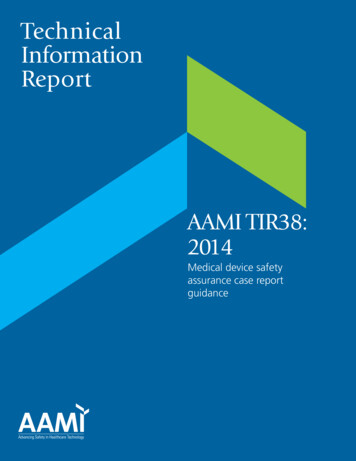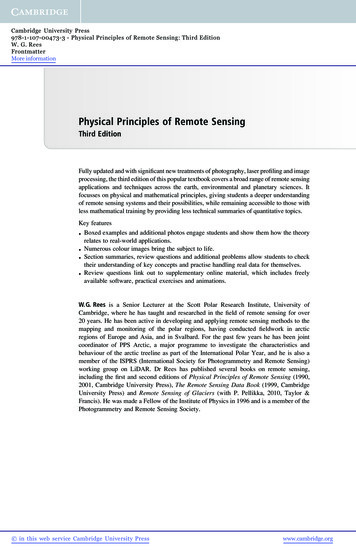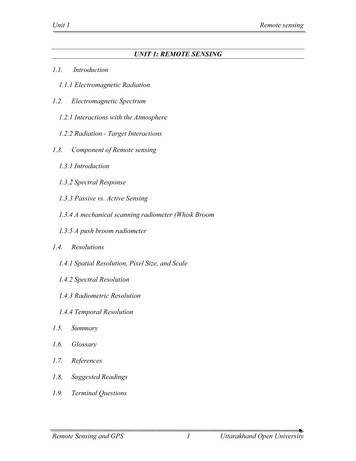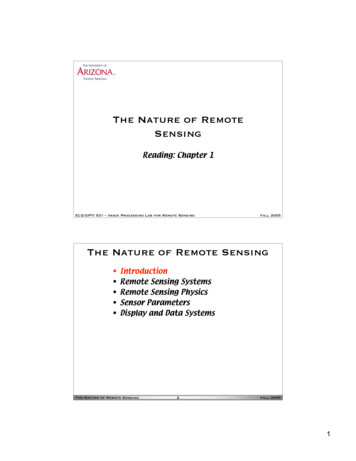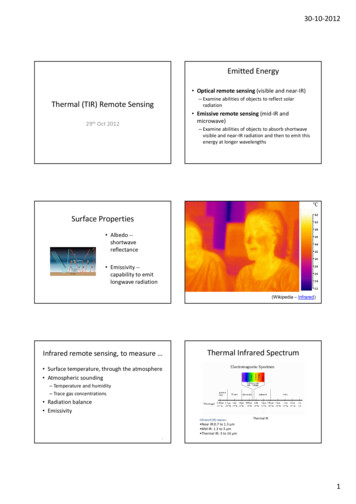
Transcription
30-10-2012Emitted Energy Optical remote sensing (visible and near-IR)– Examine abilities of objects to reflect solarradiationThermal (TIR) Remote Sensing29th Emissive remote sensing (mid-IR andmicrowave)Oct 2012– Examine abilities of objects to absorb shortwavevisible and near-IR radiation and then to emit thisenergy at longer wavelengthsSurface Properties Albedo -shortwavereflectance Emissivity -capability to emitlongwave radiation(Wikipedia – Infrared)Infrared remote sensing, to measure Thermal Infrared Spectrum Surface temperature, through the atmosphere Atmospheric sounding– Temperature and humidity– Trace gas concentrations Radiation balance EmissivityInfrared (IR) waves:Thermal IR Near IR:0.7 to 1.3 μm Mid IR: 1.3 to 3 μm Thermal IR: 3 to 14 μm51
30-10-2012Thermal IR Remote SensingThermal Remote Sensing Thermal infrared radiation refers to electromagneticwaves with a wavelength of between 3 and 20micrometers. Most remote sensing applications make use of the 3 to5 and 8 to 14 micrometer range (due to absorptionbands). The main difference between thermal infrared andnear infrared is that thermal infrared is emittedenergy, whereas the near infrared is reflected energy,similar to visible light.Atmospheric TransmissionPrinciples of Emitted Radiation The amount of radiation emitted by anobject is determined primarily by its:The windows normally used foraircraft platforms are in the 3-5micron and 8-14 micron wavelengthregionsSpaceborne sensors commonly usewindows between 3 and 4 micronand between 10.5-12.5 micronNone of the windows transmits 100 %because water vapor and carbondioxide absorb some of the energyacross the spectrum and ozoneabsorbs energy in the 10.5-12.5 micronPlanck Radiation (Blackbody) Law– internal temperature; and– emissivityBlackbody CurvesPlanck’s law solved for λ at constant TE Energy or total radiant exitance, W m-2h Placnk’s constantk Boltzmann constantc speed of light (constant)T temperature (in K)λ WavelengthPlank's Radiation Law for blackbodies gives the position of the peak and totalspectral radiance (area under the curve) of an object as a function of itstemperature2
30-10-2012Developments from Planck’s LawWien’s Displacement LawNotice that the peak of theBlackbody curve shirts to shorterwavelengths astemperature increasesThis peak represents the wavelength ofmaximum emittance (λmax)Developments from Planck’s LawStefan-Boltzmann LawWien’s Displacement Law As the temperature of an object increases, the totalamount of radiant energy (area under the curve, inW/m2) increases and the wavelengths at which theobjects emits the most energy decreases. To determine this peak wavelength (λmax) for ablackbody:λmax A/Twhere A is a constant (2898 μm K) and T is thetemperature in Kelvins. The 300 K Earth’s peak emmitance wavelength is:2898 / 300 9.7 μm, in the thermal IR What wavelength is the Sun’s radiant energy peak(6000 K)?Developments from Planck’s LawStefan-Boltzmann LawThe Stefan-Boltzmann law is derived by integrating thePlanck function with respect to wavelength:E σT4The area under the Planck curverepresents the total energy emitted byan objectat a given temperatureσ is called the StefanBoltzmann constant.σ 5.667 x 10-8The Stefan-Boltzmann lawgives this energy for a blackbodyEnergy or the radiant flux (rate of flow of EM energy)Stefan-Boltzmann Law: the amount of energy emitted from an objectis primarily a function of its temperature.Interaction of Thermal Radiation withTerrain ElementsInteraction of Thermal Radiation withTerrain ElementsThe energy radiated from an object usually is the result of energyincident on the featureε( λ ) α ( λ )E I E A E R ETThe energy incident onthe surface of the terrain elementE I E A E R ET 1EI EI EI EIα ( λ) Absorptance of the terrain elementEAEE, ρ ( λ) R , τ ( λ) TEIEIEIKirchhoff radiation law states that the spectral emissivityof an object equals to its spectral absorbance(Good absorbers are good emitters):So:ε( λ ) ρ ( λ ) τ ( λ ) 1Assuming opaque objects:ε( λ ) ρ ( λ ) 1Transmittance of the terrain elementReflectance of the terrain element3
30-10-2012Basic ThermalRadiation Principles Kinetic temperature: Internal temperature ofan object determined by random molecularmotionInteraction of Thermal Radiation withTerrain ElementsThe kinetic temperature of an object is relatedto its radiant temperature by:Trad ε1/ 4 Tkin Thermal scanning detects energy which isfunction of temperature (radianttemperature); Radiant flux emitted by a bodyat a given temperature.Emissivity ERM is emmitted by all objects above absolute zero(0k, or -273 c), and the magnitude and spectral range ofthe emitted ERM is governed by the temperature andemissivity of the material Kelvin Celsius 273 There are no blackbodies is nature. Blackbody is a hypothetical, ideal radiator that perfectlyabsorbs and reemits all energy that is incident upon it. All natural objects are graybodies, they emit a fractionof their maximum possible blackbody radiation at a giventemperature.Thermal sensors detect radiation from the surface of groundobjects (approximately the first 50 µm)Basic ThermalRadiation Principles Emissivity (ε) describes the absorption and emissionproperties of real objects. It is the ratio of the emittance(radiant flux) from an object at a given temperature to thatof a blackbodyε(λ) radiant flux of an object at given temperature/radiant flux of a blackbody at same temperatureε varies with wavelength and somewhat with temperatureIf the emissivity of an object varies with wavelength, the object is said to bea selective radiantBasic ThermalRadiation PrinciplesBasic ThermalRadiation Principles A graybody has ε 1 but is constant at allwavelengths. At any given wavelength, the radiant flux froma graybody is a constant fraction of that of ablackbody. Many materials radiate like blackbodies over certainwavelength intervals. Most thermal sensing is performed in the 8-14 µmregion of the spectrum not only because it includesan atmospheric window, but because it contains thepeak energy emissions for most surface features.4
30-10-2012Basic ThermalRadiation PrinciplesBlackbody/Graybody/Selective Radiator For any given material type, emissivity is oftenconsidered constant in the 8-14 µm range(graybodies)BUT Values vary considerably with wavelength Value vary considerably with material conditionSpectral emissivity of ablackbody, a graybody,and a hypotheticalselective radiatorSpectral radiantexitance distribution ofthe blackbody,graybody, andhypothetical selectiveradiatorEmissivity vs. WavelengthSand, Soil, Asphalt, Water5
30-10-2012Thermal Spectra of MineralsEmissivity of Common MaterialsDry mineral soil 0.92-0.94paint0.90-0.96Dry vegetation 0.88-0.94Dry snow0.85-0.90Granite rock 0.83-0.87Glass0.77-0.81Sheet iron (rusted) 0.63-0.70Polished metals 0.16-0.21Aluminum foil 0.03-0.07Highly polished gold 0.02-0.03Clear water 0.98-0.99Wet snow 0.98-0.99Human skin 0.97-0.99Rough ice 0.97-0.98Vegetation 0.96-0.99Wet soil0.95-0.98Asphalt concrete 0.94-0.97Brick0.93-0.94Wood0.93-0.94Basalt rock 0.92-0.96 In an ideal situation, theemissivity of an object especially if recorded overseveral wavelength regions - maybe used touniquely identify that featureEmissivityEmissivity—objects are notblackbodiesThe emissivity of an object may be influenced by a number factors, including: color -- darker colored objects are usually better absorbers and emitters (i.e. theyhave a higher emissivity) than lighter colored objects which tend to reflect more ofthe incident energy. surface roughness -- the greater the surface roughness of an object relative to thesize of the incident wavelength, the greater the surface area of the object andpotential for absorption and re-emission of energy. moisture content -- the more moisture an object contains, the greater its ability toabsorb energy and become a good emitter. Wet soil particles have a high emissivitysimilar to water. Kirchhof’s Law: emissivity absorptance– Probability of emission of a photon at a givenfrequency and angle is same as probability ofabsorption at same frequency and angle Emissivity Reflectance Transmittance 1– (all functions of wavelength and angle) compaction -- the degree of soil compaction can effect emissivity. field-of-view -- the emissivity of a single leaf measured with a very highresolution thermal radiometer will have a different emissivity than an entire treecrown viewed using a coarse spatial resolution radiometer. wavelength -- the emissivity of an object is generally considered to bewavelength dependent. For example, while the emissivity of an object is oftenconsidered to be constant throughout the 8 - 14 mm region, its emissivity in the 3 -5mm region may be different.Definition of brightness temperatureTB)λ 5 ehc kλT 1So TB Or T B ε λ (θ )(2hc 2Relationship between T and TB0-2)λ 5 ehc kλT 1-4-6hc-8TB -T(2hc 2 ε ehc k λT 1 k λ ln ε hc(44k λ ln 1 ε ε e hc kλTB-10-12270, 0.9270, 0.8300, 0.9300, 0.8-14-16-18)-2002468101214wavelength, µm45466
30-10-2012“Split-window” methods—atmospheric correction for surfacetemperature measurementSea-surface temperature, June 22,2000 Water-vapor absorption in 10-12 µm window is greater than in3-5 µm window– Greater difference between TB (3.8 µm) and TB (11 µm) impliesmore water vapor– Enables estimate of atmospheric contribution (and therebycorrection) Best developed for sea-surface temperatures– Known emissivity– Close coupling between atmospheric and surface temperatures Liquid water is opaque in thermal IR, hence instruments cannotsee through clouds47Thermal Properties of MaterialsThermal conductivity K (cal.cm-1 ּ sec-1 ּ oC-1)is a measure of the rate at which heat passes througha material heat passes through metals much faster than throughrocks Water has a higher K value than many other materials It takes a longer time for water to transfer heat over agiven distance than many other materialsThermal Properties of MaterialsThermal capacity C (cal/g-1oC-1) determines how well amaterial stores heat. Water has a high thermal capacity compared to othermaterial types It takes more energy for water to warm up to the sametemperature than many other materials do Rank of heat capacityWater forest grass land In other words, for a given amount of energy, waterwarms up slower than many other materialsThermal Properties of Materials Thermal Inertia (P) -- Resistance of a material totemperature change. It increases with an increase in material conductivity,capacity, and density In general, materials with high thermal inertia havemore uniform surface temperatures throughout theday and night than materials of low thermal inertiaThermal PropertiesStainless steel shows the smallest temperature fluctuations during a24-hr heating/cooling cycleSandy soil shows the largest temperature fluctuations7
30-10-2012Important Thermal IR Sensors TIROS (Television IR Operational Satellite), launched in 1960GOES (Geostationary Operational Environmental Satellite), TIR at 8 kmspatial resolution, full-disk of Earth day and nightHCMM (Heat Capacity Mapping Mission), launched in 1978- 600 m spatialresolution, 10.5 – 12.6 micron rangeCZCS (Coastal Zone Color Scanner) on Nimbus 7, launched in 1978, for SSTAVHRR (Advanced Very High Resolution Radiometer), 1.1 and 4 kmTIR bands TIMS (Thermal Infrared Multispectral Scanner), Airborne, 6bandsATLAS (Airborne Terrestrial Applications Sensor)Landsat ETM Band 6- 10.4 – 12.5 micron rangeASTER (Advanced Spaceborne Thermal Emmission and ReflectionRadiometer) on Terra, 5 bands :8.125-11.65 micron rangeInfrared spectral regionsattributes3.5–4.5 µm Clearest atmospheric(Mid IR) window and finestspatial resolution formeasuring temperature.8–12 µm(ThermalIR)disadvantagesCloud cover. Lessenergy than 8–12 µm.Mixed with solarradiation in daytime.Atmospheric window. Cloud cover. CoarserPeak of energyspatial resolution thanemitted from Earth.MWIR.Most accurate temperatures.54Geometry of Thermal Images Tangential scale distortion- caused by varied viewing distance Aircraft instability- roll: side by side motion- crab (yaw): by compensating drift- pitch: head/tail motionGeometry of Thermal Images Relief displacement- differs from that of aerial photography- vertical features on thermal images displaced fromthe nadir for each scan- vertical features on air photo displaced radiallyfrom the principal point8
30-10-2012Interpreting Thermal Scanner Imagery Application in:– Determining rock types, structuresoil types, soil moisture– Locating water springsforest fires, subsurface fires Qualitative information collection:relative differences in radiant temperaturesInterpreting Thermal Scanner Imagery Landscape factors- surface material: land vs. water- topography: sunlit vs. shadowed- vegetation cover: land, grass, forest, water- moisture Quantitative data analysise.g. water temperatures Times of day (diurnal temperature variations)– Thermal images will vary in appearance depending on whether they areacquired during the warm part of the day or after a night of absence ofthe sun and resultant cooling of the atmosphere as well as heat loss fromthe surface and shallow depths beneath Temperature extremes, heating & cooling ratesChanges in radiant temperatures of five surface-cover typesduring a 24-hour thermal cycleInterpreting Thermal Scanner Imagery Direct sunlight heats objects according to their thermalcharacteristics and sunlight absorption Predawn imagery: stable temperatures Darker tones: cooler temperatures BUT, Limitations– thermal images contain noise and errors– differences in emitted energy is not directly related to differences intemperature, must know emissivity of each material– sensors only record the radiance at the surfaceDay versus Night ImageDayNightDay image: Contrasts between heated buildings and streets and areas in shadow createa scene that resembles an aerial photoNight image: Many streets are evident because, being asphalt paved, they absorp moreheat and remain warmer through the night9
30-10-2012Pre-dawn Thermal Infrared Image of Effluent Entering the Savannah River SwampSystemSavannahRiver2x reductionMarch 31, 19814:28 am; 3 x 3 mGreat Lakes -- NightMultispectral Thermal SpectroscopyTM band 6 on LandsatThe land appears cool (darker tones) with little detail10
30-10-2012RGB TIMS Composite Image: Death Valley1,3,5 RGBNASA’s Earth Observing System—missions with IR capability TRMM– CERES Landsat-7 (launched April 1999)– ETM has 60 m band at 10.5-12.5 µm EOS Terra (launched December 1999)– CERES, MODIS, ASTER, MOPITT EOS Aqua (launched May 2002)– AIRS, CERES, MODISAlluvial fans appear in reds, lavender, and blue greens; saline soilsin yellow; and other saline deposits in blues and greens. EOS Aura (launched July 2004)– HIRDLS, TES74CERES—Cloud-Earth Radiant EnergySystemASTER—Advanced SpaceborneThermal Emission and ReflectionRadiometer 14 bands (15-90m) in VIS, NIR, SWIR, andTIRShortwave infraredThermal infraredMauna Loa images76ASTER spectral bands on modelatmosphereASTER Bands 432 RGB This ASTER sub-scenewas acquired on May20, 2000 and showsan area in west centralOregon. In this composite,snow appears blue,forests are green, andclear-cut areas areorange-pink.11
30-10-2012MODIS—Moderate-ResolutionImaging SpectroradiometerAIRS—Advanced Infrared Sounder 36 bands, 1 in SWIR, 6 in mid IR, 10 in thermalIR Measurements of– Surface/cloud temperature– Atmospheric temperature– Cirrus clouds and water vapor– Ozone– Cloud top altitude 2400 bands in IR (3.7-15 µm) and 4 bands invisible (0.4-1.0 µm)– Absorption “signature” around 4.2 µm and 15 µm(CO2) and 6.3 µm (H2O) enables temperature andhumidity sounding to 1 km vertical resolution– Spatial resolution is 13.5 km Complemented by microwave sounders todeal with clouds79HIRDLS—High-Resolution DynamicLimb Sounder80TES—Tropospheric EmissionSpectrometer Sound upper troposphere, stratosphere, andmesosphere for temperature and a variety ofgases High-resolution infrared-imaging Fouriertransform spectrometer– Spectral coverage of 3.2 to 15.4 µm at a spectralresolution of 0.025 cm–1– Line-width-limited discrimination of mostradiatively active gases in the Earth's loweratmosphere– O3, H2O, CH4, N2O, NO2, HNO3, N2O5, CFC-11, CFC12, ClONO2 21 bands from 6.12 µm to 17.76 µm8182Ocean surface temperature fromMODISOperational Missions MODIS ocean web site Click on Quality Assurance to get the browsetool [intuitive?] GOES (Geostationary Operational Environmental Satellites)– Imager and sounder POES (Polar-Orbiting Environmental Satellites, i.e. AVHRR)– Two satellites provide coverage with maximum delay of 6 hours– Latest is NOAA-15, launched May 13, 1998 NPOESS (National Polar-Orbiting Environmental SatelliteSystem)– Joint NOAA/NASA/DoD mission– Launch no earlier than 2011– Imaging, microwave, and sounding instruments838412
30-10-2012Land surface temperature from MODIS Go to the MODIS Land Global Browse page Select the MOD11/MYD11 checkbox (SurfaceTemperature) Enter date range Select satellite (Terra and/or Aqua) Select Collection (5 is most recent)Active firedetection MODISFire andThermalAnomalywebsite8586How does all this work?Dr. Wan’s equation is As noted in previous lecture, a great feature ofNASA’s EOS program is that the algorithms arepeer-reviewed and published in algorithmtheoretical basis documents Each instrument has a page with links to theseATBDs, e.g. for MODIS, one can go to ZhengmingWan’s ATBD for land surface temperature1 ε ε T T32 Ts C A1 A2 A3 2 31εε 2 1 ε ε T31 T32 B1 B2 B3 2 εε 2 whereT31 , T32 brightness temperatures in bands 31,32ε – The algorithm uses MODIS bands 31 (10.78-11.28µm)and 32 (11.77-12.27µm)ε 31 ε 32and ε ε 31 ε 322A, B, C coefficients given by multidimensional lookup tables(they depend on angle)8788Fire detection–11.0E-01–11.0E-02–2 Planckequation is asteeperfunction of Tat shorterwavelengthsPlanck radiance, W m µ m srSpectral emissivity 750Temperature, K1000125015009013
30-10-2012Consider a pixel with a small fireCan solve for f, Tf, if Tb is known1.0E-02L j fB j (T f ) (1 f ) B j (Tb )f fraction of pixel on fireT f fire temperatureradiance1.0E-03Tb background temperature1.0E-04750,3.8750,111000,3.8B j Planck radiance in band j1000,111.0E-051250,3.8L j sensor radiance in band j1250,111.0E-060910.0250.05fire fraction0.0750.19214
30-10-2012 1 Thermal (TIR) Remote Sensing 29 th Oct 2012 Emitted Energy Optical remote sensing (visible and near-IR) -Examine abilities of objects to reflect solar radiation Emissive remote sensing (mid-IR and microwave) -Examine abilities of objects to absorb shortwave
